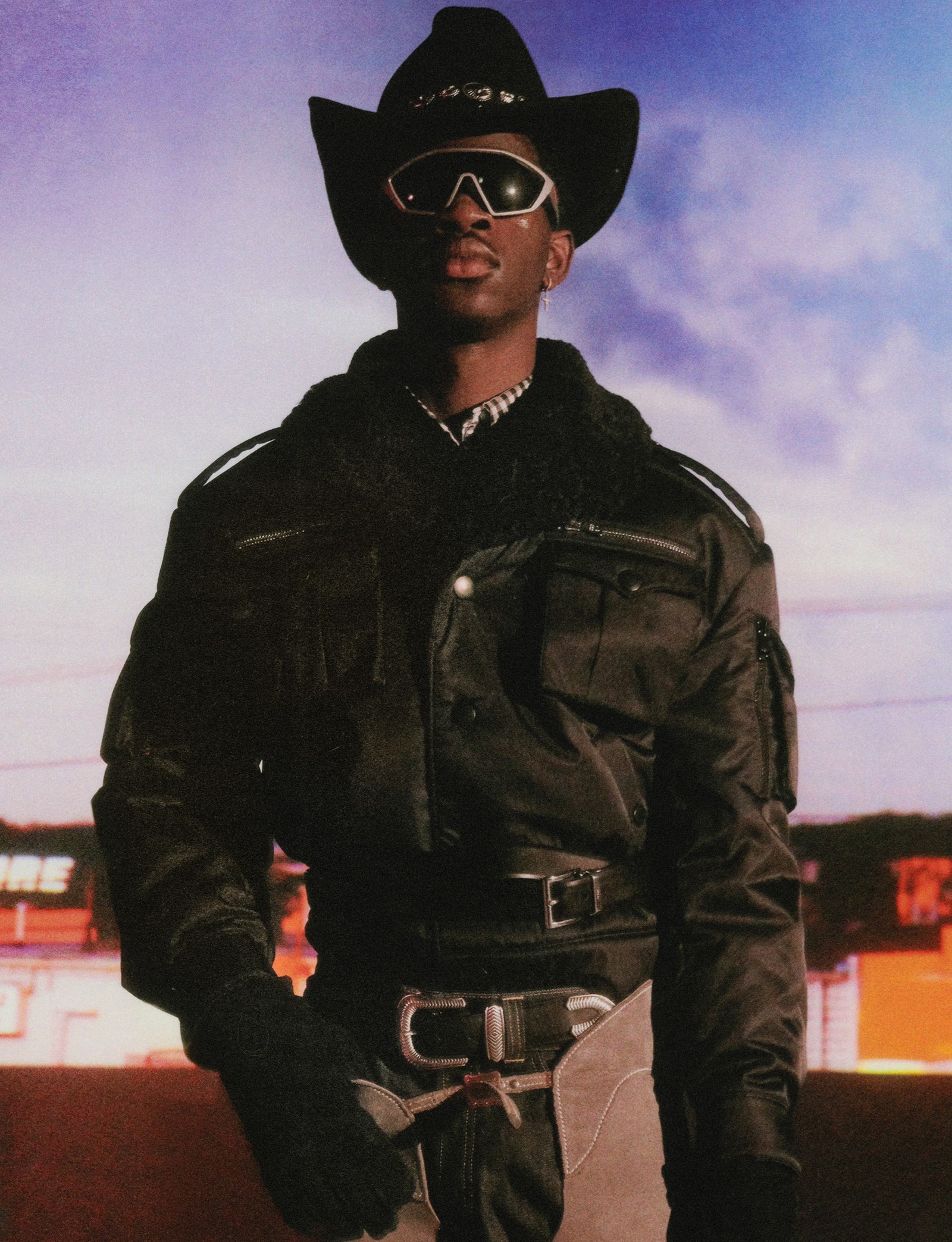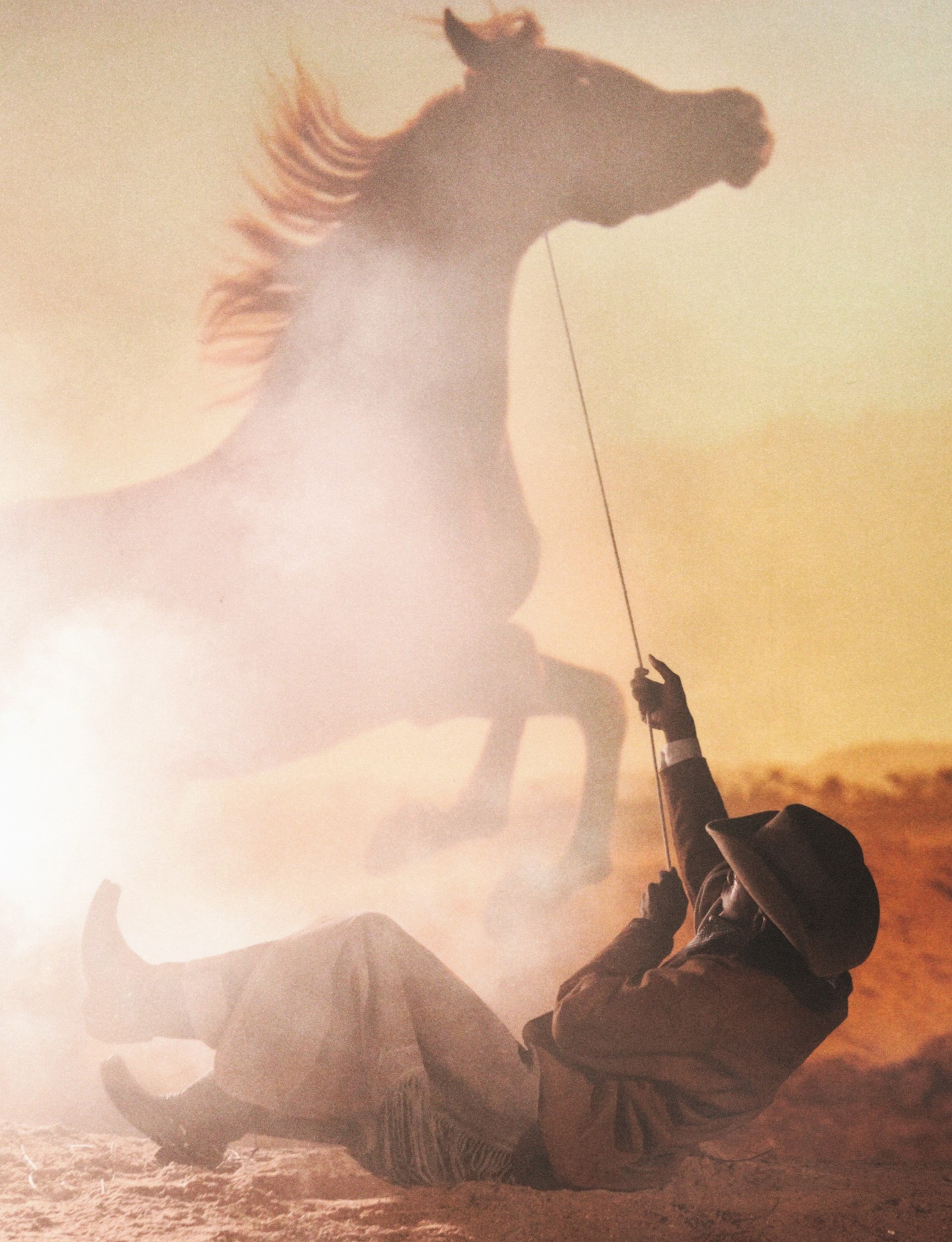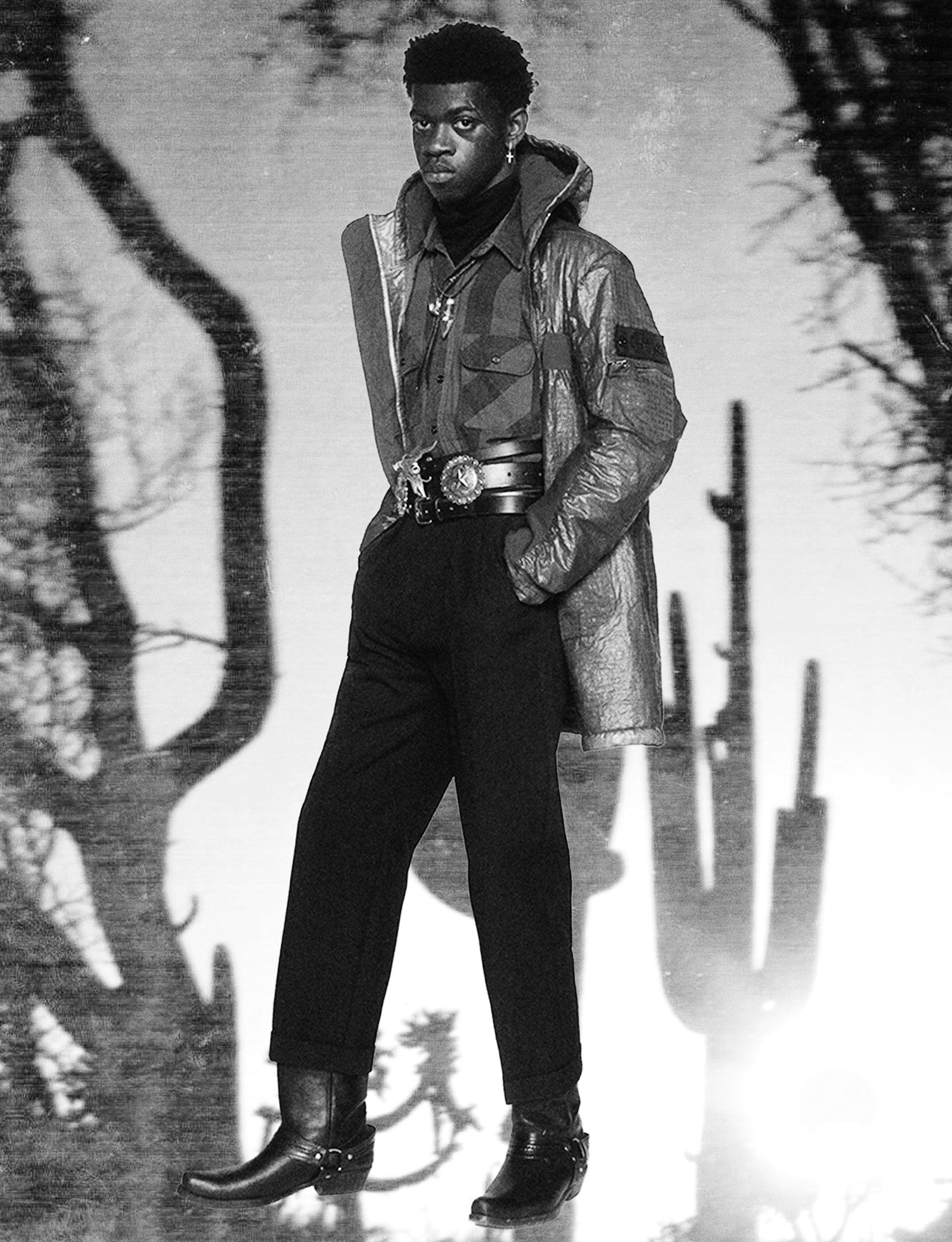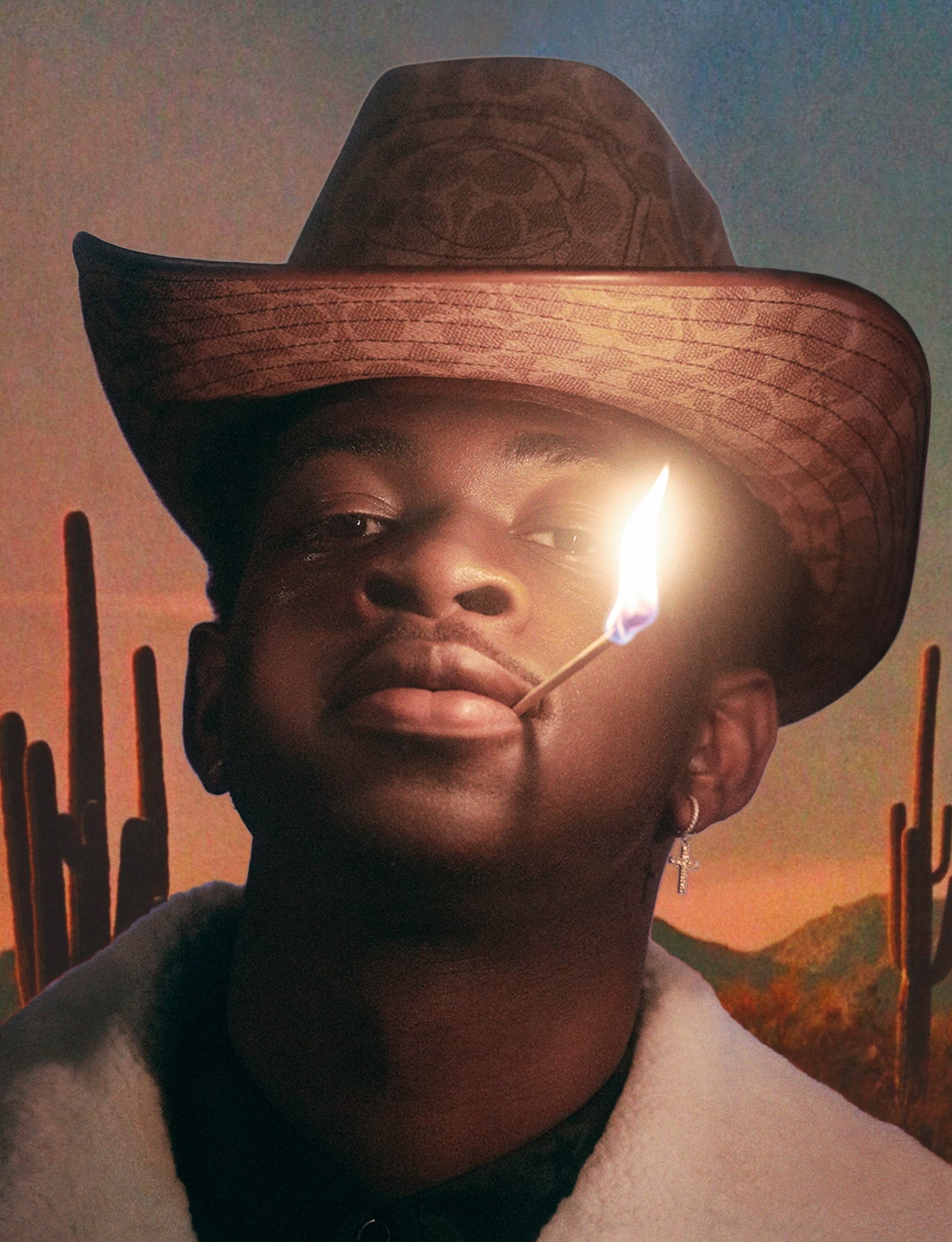Taken from the autumn 2019 issue of Dazed. You can buy a copy of our latest issue here
Of all the figures roaming American pop mythology, the cowboy might be the loneliest. A new wave of literature in the late 19th century introduced a figure who seemed predestined to be bruised; a mostly silent outlaw archetype magicked from the fringes of a village community. A 1902 book called The Virginian, considered the first true ‘western’ outside of the dime novel tradition, joins a young ranch hand at an emotional crossroads. Can he continue to live inside of the law, and society’s norms, when he feels so at ease with his own violence? Ultimately, like in many cowboy tales to follow, his sadness takes a hold of him.
Even at their burliest, cinema’s cowboys would always saddle into the gloam alone at the end of a scene: John Wayne as the shamed drunk marshal with an eye patch in 1969’s True Grit; Henry Fonda as the avenging outlaw bounding from murder to murder with tumbleweed nihilism in Fritz Lang’s The Return of Frank James (1940). In 1954’s musical western Seven Brides for Seven Brothers, cowboy siblings bond over a feeling of anxious isolation rather than familial loyalty. “Can’t make no vow to a herd of cows,” sings Caleb, on “Lonesome Polecat”.
In country music, the mid-70s ‘outlaw movement’ fronted by Willie Nelson and Waylon Jennings politicised the lonesome cowboy image. “These were musicians who didn’t think Nashville was serving them well,” says Travis Stimeling, a country music historian and musicology professor at West Virginia University, of the industry’s Tennessee mecca. “They started using cowboy rhetoric as a way of standing out from the country mainstream.”
At the end of last year, the myth of the ‘lonesome cowboy’ crept into the imagination of a 19-year-old rapper from the Atlanta suburbs. “I literally saw myself in a movie,” he recalls, “a loner cowboy western. I wanted to run away from everything.” Montero Lamar Hill – now better known as Lil Nas X – had found himself on a strange peninsula, between the computer science degree he was eager to flunk out of and the house his father lived in with his stepmother, 30 minutes from the heat of trap city. Running away from home to live on his sister’s living-room floor, Hill had felt dislocation before, but nothing like this. Scrolling through YouTube for instrumental beats, the rapper came across a banjo-plucked synth song with an 808 drop that could sink Das Boot.
Made by a then-unknown Dutch producer called YoungKio, the beat knits a Nine Inch Nails sample into drum patterns that swing lower and knock together warmer than the trap that made Atlanta famous. It was the industrial band’s rheumatic and tightly coiled strings that painted a picture in Hill’s mind. “It had this loner runaway thing going on,” he says of the track that became “Old Town Road”, a song that is now more a moment in time than music. “I knew this was my chance to break out, and if I didn’t push this as hard as I could all day and night, I was gonna fail myself.” He began to envision ways he could avoid colour-by-numbers trap and set his narrative against a country-and-western vista.
When Hill enters the red clay set for the video to “Old Town Road” – which co-stars Diplo, Vince Staples and Chris Rock – he isn’t just wearing spurs and fringed chaps, the usual cowboy getup. He’d had Indiana-based designers Union Western imagine a black suit embroidered with racing-pink and electric-blue unicorns – the kind made for events such as the Rose Parade, where prestigious carriages lined the streets of Pasadena. Hill has been immersed in character ever since his “Old Town Road” revelation, lacing his earlobes with miniature horse shoes and elongated leather tassles that remix the ‘bolo tie’ shape worn by movie sheriffs. Looking like one of Kenneth Anger’s kaleidoscopic Hell’s Angels on the set of this cover shoot, Hill is the hero figure of a narrative thread that traces back centuries of American history.
“The ‘countryness’ is pretty much in my blood. I’m from Georgia, down south. That voice just lives in me” – Lil Nas X
Before “Old Town Road”, Hill rapped over spring-loaded hi-hats and vinyl-scratched soul samples on his debut mixtape Nasarati. His early sound wasn’t quite outre enough to shake up Atlanta, home to the nuclear fallout hip-hop of Young Thug and Lil Yachty, but melodic enough to swerve cumbersome comparisons to most of the scene. The rapper had one thing his competitors didn’t: a profound ability to steer the attention of the internet.
“In 2017, I enjoyed my time on the internet more than doing things in real life,” remembers the now 20-year-old rapper, whose father is a gospel singer. It was around this time, when he began using Twitter memes to generate buzz around his Soundcloud, that he started to feel a sense of control online. To better understand the kind of content people responded to, Hill set up over a hundred fake fan accounts across a variety of pop culture pitstops, making him the JT Leroy of the internet. “Nothing too deep or anything,” he says, and it’s difficult to tell if he’s joking. “It might have been, like, a random sports fan account or something. (I wanted to see) what was going on and what other people were reacting to.”
By the time he’d bought the rights to the YoungKio beat, Hill had been asked to leave his sister’s flat, and had just under six dollars left in his Wells Fargo bank account. “I told college I was gonna take a semester off, but I knew I was never going back,” he remembers. “I felt like the walls were closing in on me.” All the malaise of this period – the feeling of having nothing left to lose, and being freed by that – found its way into “Old Town Road”. “I knew exactly what I had to do on the beat, I was just hoping nobody thought of it before me.” The namesake road was the journey that he hoped would lead him out of despair. The horse in the song’s opening line marked the mentality of an underdog; the popular carriage that was replaced by the car.

Hill was aware that his new experiment had the potential to move the needle, posting the track with a ‘Country Trap’ tag on Soundcloud, and declaring on Twitter that “country music is evolving” hours before its official release on December 3, 2018. “Lil Nas X took the country vibes vocally,” YoungKio told Billboard magazine, referring to the southern twang Hill glides in and out of in couplets like “Can’t nobody tell me nothin’ / you can’t tell me nothin’”. Hill, who was lost so deeply in the protagonist he had dreamt up for the song, isn’t sure how conscious these tweaks were. “For one, the ‘countryness’ is pretty much in my blood,” he observes. “I’m from Georgia, down south. That voice just lives in me.”
Away from Twitter, where the sheer volume of his outpourings can seem untamable and noisy, Hill is calm, speaking slow and bassy and cackling when I remind him of his joke tweet about the ‘horses in the back’ line from “Old Town Road” being a reference to climate change. Hill is aware of how obsessive he seems online, and his gallows humour has come out in refreshing ways. In January, he posted a selfie while high on painkillers in the middle of tooth surgery, and his current avatar picture was also taken in hospital after he was diagnosed with pneumonia. A favourite fan meme, he tells me, was set at a funeral procession. “There was a coffin and it was like his last ride, and he was inside the hearse and they were playing “Old Town Road”. I was like, ‘Oh my God.’”
When we speak over the phone in June, there’s a static fug palpable from the other end of the line, the sort that usually anticipates lightning. Hill is hours away from releasing his debut EP, 7, on Columbia, and “Old Town Road” is enjoying its 11th straight week at the top of the Billboard 100 chart, having broken Drake’s record for the most US streams in one week by a 25 million-plus margin. The different ways in which the song went from Soundcloud to record-breaking virality, laying waste to both record industry codes of practice and its marketing models, already feels written into legend.

Hill has spoken at length about the ways he wrote in “Old Town Road”’s meme-ability (“I was like, ‘I gotta make sure this song has quotables in it,’”), but the biggest fire lit for the track was on TikTok, an app in which users share 15-second homemade clips. A Massachusetts man called Michael Pelchat – or @nicemichael, to his six-figure TikTok following – found a meme clip of “Old Town Road” back in late January, and decided to dance to it on his channel. The set-up was simple: appear at the start of the clip in your usual clothes, and transform into full cowboy attire at the click of the bass drop. By early March, Pelchat had reached more than 100,000 people, and many were replicating the format under the hashtag #TheYeehawChallenge. He believes that “Old Town Road” and the Yeehaw Challenge have cleared a bright new path for music marketing, one that signals the death of the traditional music video. “I can guarantee you it is better for an artist to invest in a content creator to make a video,” says Pelchat, who now charges hundreds of dollars for clips off the back of his “Old Town Road” break. “They can easily drop a music video on their YouTube channel with no followers, but they’re not tapping into a new market.”
Ultimately, it was the internet as a whole that spun Hill’s song into a cultural cataclysm, and the internet that came to its defence after an attempt to silence it. In March, Billboard removed “Old Town Road” from its country-music chart, and their ahistorical statement – about the song not having the right blend of country music ingredients to qualify for it – was a reminder of the long shadow the Nashville establishment still casts over the industry. “Clearly, race is vital to Billboard’s rejection of the original song, (and) it is undeniable that many high-ups in the country music industry are interested in policing the racial boundaries of the music, trying to ensure the ‘whiteness’ of the genre,” says Tore Olsson, a historian and lecturer at the University of Tennessee.
“Musically speaking, it’s not that far off from what’s happening in a lot of mainstream country music today,” adds Stimeling, whose job it is to trace the genre’s subtle evolution. Hip hop has an undeniable presence in the country-music mainstream, he argues, from “Over and Over”, a 2004 collaboration between Nelly and country favourite Tim McGraw, to Meghan Linsey and Bubba Sparxxx’s 2014 song “Try Harder Than That”. “Country is more blocked off and this was a pierce,” Hill told journalist Zach Sang. “It’s like, ‘If we allow this, what the fuck is next?’”

“What’s interesting is that all of this is hardly new – it goes back to the 1920s and 1930s, where commercial ‘country’ music has its origins,” says Olsson. “At that time the music was a genre born of southern black, white, native American and European (sounds) – but record labels insisted on splitting it in half and marketing white musicians as ‘hillbilly’ singers and black musicians’ songs as ‘race records’, even if both were drawing from the same well, and playing each others’ songs. The genre we know today as ‘country’ has always grown out of a multiracial set of musicians and inspirations, it’s just the record companies that have insisted on segregating the sounds.”
Johnny Cash, another country-music outlier, sprang into the mind of Billy Ray Cyrus when he first met Hill, who had asked him to appear on a remix of “Old Town Road”. Cyrus was eating in a cafe when he was handed a phone to listen to the track for the first time. He bolted up in his chair. Like Hill, Cyrus had been shunned by the Nashville community in the 90s, who dismissed his breakthrough “Achy Breaky Heart” – which came with a dance routine and a music video glossed up like a Wrangler advert – as a one-hit wonder. Clearly, there was something in Hill’s sound that spoke to Cyrus’s inner outsider, his own understanding of the loner cowboy myth. “When I got thrown off the charts, Waylon Jennings told me, ‘Take this as a compliment, (it) means you’re doing something great,’” Cyrus wrote in a tweet directed at Hill in April. “Welcome to the club!” Later, in June, Hill joined Cyrus and his daughter, Miley, onstage at Glastonbury to perform “Old Town Road”. There, three very different kinds of pop star danced in the face of a grand tradition that usually has the last laugh.
Later in the show, Hill played “Panini”, the second single from 7. The track interpolates a moment from Nirvana’s Wall of Sound-esque Nevermind track “In Bloom”, and finds Hill bouncing off the synths of a museum-piece arcade machine, a million miles from the arid plains of “Old Town Road”. The EP never stays in one place, sonically, standing as both a celebration of the freedom of “Old Town Road” and a departure for other pastures. “F9mily (You & Me)” is Stevie Nicks-ish drivetime rock written with Blink-182 drummer Travis Barker, and “Kick It”, Hill’s favourite of the seven songs, is haunting backpack rap overwashed with craning violins. After he came out in June, Hill took to Twitter to explain the real meaning behind the line “I need to let go, use my time to be free” from “C7osure (You Like)”, and the rainbow pattern colouring a cityscape in the EP’s futurist-western artwork. The honesty planted in “C7osure” opens up the Lil Nas X story to a new audience, and a fresh conversation chapter relating to perceptions of rappers and sexuality. “This society has him now,” tweeted Mykki Blanco in July, allying Hill with the wider queer community.
“For the majority of kids growing up today, (Hill) is the first cowboy they’ve ever seen. When they find out the detailed history of black cowboys, they won’t be as shocked as people seem to be today” – Bri Malandro
For all the facts, figures, retweets, memes and smashed records underpinning the success of “Old Town Road”, witnessing its impact in a real-world setting is still shocking. Currently, it has the power to rip the bottom out of dancefloors across the world, and one viral video shows the Texas Tech American Football team destroying a locker room to the song after a match. Another clip, posted in May, shows Hill performing the song to elementary school kids, who dip, twist, rise and sit to Hill’s gestures like a starling murmuration. “(Hill) said, ‘I need y’all to be quiet’ a single time and got an entire school to shut up,” 22-year-old Eric, a Lil Nas X fan from Pennsylvania, tells me. “There’s not another living artist with that kind of influence.”
But for Bri Malandro, who runs the Instagram page The Yeehaw Agenda, the clip holds a far more profound significance. Malandro coined the term after seeing Ciara wear a white cowboy hat on the cover of King Kong magazine last September. She started the account to document the various other black cowboy moments she could find across pop culture, from musician Oyinda’s outfit at Telfar’s AW19 fashion week show, to 21 Savage in a fringed western jacket for a Saint Laurent campaign.
“The video made me realise that, for the majority of kids growing up today, (Hill) is the first cowboy they’ve ever seen,” says Malandro. “When they find out the detailed history of black cowboys, they won’t be as shocked as people seem to be today – because they’ll have known about him.” Stimeling points out that, after the civil war, an estimated one in four cowboys in the US were African-American. More broadly speaking, he argues, the erasure of the black cowboy from popular culture is clogged in the industrial mechanisms that made the censorship of “Old Town Road” such an urgent piece of controversy. Hill, who credits the country-trap sound to his Atlantan elder Young Thug, says he is “hoping this opens the door for even more acceptance, within all and any genre”.

It’s strange for Hill to see a song he wrote about feeling like a social pariah one summer become something so much larger than that, and so quickly. “Old Town Road” challenged every preconceived notion about making a hit record, and continues its reign over the semantics of this moment. But the musician seemed to glean its importance even as he was writing it. More than once, he has described the song as a self-fulfilling “manifestation” of his own life and his unique approach to work, and calls the months spent promoting it on two hours of sleep a night a “shaking moment”.
“I literally felt like something came over my body... it was almost scary,” Hill said in a YouTube interview from May about the surge of ambition he felt at his sister’s flat. “Beyond music, huge, like something I can’t even imagine right now.” The X in his name refers to a ten-year plan to achieve ‘mogul’ status, but today, looking to the future, he isn’t yet certain what kind of mogul he’ll become. Against all logic, Hill doesn’t feel dwarfed by the success of “Old Town Road”, because his plan is something grander than music, something closer to an ongoing art project that sends seismic shudders through culture.
In a behind-the-scenes still from the “Old Town Road" video, Cyrus is teaching Hill some of the line-dancing moves that got him banned from Nashville so many years ago. Hill’s grills shimmer against a ray of sunlight, and for a moment, the pair are locked into the same groove with the power of fighting bulls. There’s something calm and absurd about the photo that seems at odds with what their coming-together actually means: two cast-offs motioning gracefully in plain sight, as the conversation they have led boils away on the internet.
The 7 EP is out now
Hair Cyndia Harvey at Art Partner, make-up Daniel Sallstrom at Management + Artists using Pat McGrath Labs, set design Alice Kirkpatrick at Streeters, photography assistants Callum Toy, Michael Drummond, styling assistants Mei Ling Cooper, Mollie Leaver, hair assistant Pål Berdahl, make-up assistant Carole Méthot, set design assistants Tomasz Niewinski, Jessica Coleman, Nina George, runners Maha Zia, Joseph Enchenique, digital operator Grace Difford, production Mini Title









